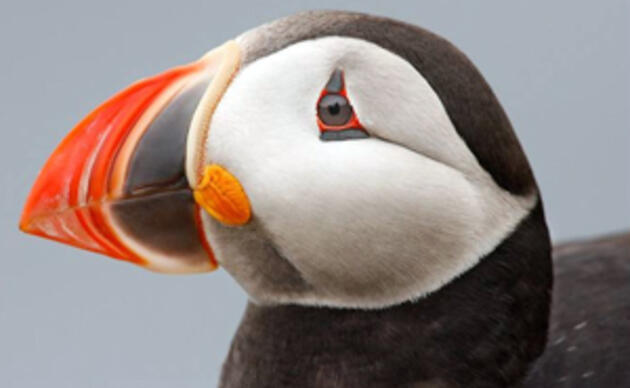The summer WEATHER was unusually wet and foggy. Tropical storm Andrea soaked Maine’s tern colonies on June 7th and later storms caused further havoc for tern chicks. The rain also caused the rampant growth of bindweed over puffin and tern habitat. PREDATORS also significantly affected productivity on Jenny Island where two minks and a Black-crowned Night-Heron raided the tern colony. Peregrine Falcons visited several islands regularly, causing colony disruptions and taking adult puffins and terns. FOOD was relatively abundant for terns on all islands this summer, but not for puffins or black guillemots on Matinicus Rock and Seal Island. In contrast, Egg Rock puffins found ample food. At Egg Rock, white hake, herring and sand lance dominated puffin chicks’ diet. Butterfish was scarcer than in 2012, but the even more difficult-to-swallow Atlantic Moonfish showed up for the first time in tern nests on all seven islands. Fortunately, it began showing up when most terns had already fledged their young.
Eastern Egg Rock
- 111 puffin pairs nested; 91% of their chicks fledged – the highest rate on the Maine coast.
- Roseate Terns increased 17% since 2012, to 83 nesting pairs with 77 fledglings.
- Common Terns remained stable at 831 pairs with 590 fledglings, rearing their young mainly on hake and herring; an early June downpour greatly reduced nesting success.
Also see: http://projectpuffin.audubon.org/sites/default/files/documents/islandhig...
Seal Island NWR
- The high count of puffins was 358, just half of the 2012 high count (737).
- 25 pairs of Great Cormorants nested; seven puffins were tagged with geolocators to learn more about their winter migration, and the now-famous Red-billed Tropicbird returned for the 9th consecutive year.
- Arctic terns remained stable at 1,039 pairs, fledging 686 young, while Common Terns declined to 1,448 pairs, fledging just .31 chicks per pair – the poorest nesting success since the colony was restored in 1989. Most losses occurred following tropical storm Andrea.
- Razorbills increased to a new record high of 21 pairs, with just over half the pairs fledging a chick -- the best nesting success yet. In contrast, Black Guillemots fledged just .20 chicks/pair; food for chicks was scarce and many died of starvation.
Matinicus Rock
- Arctic Terns benefitted from abundant hake and herring early in the season and .85 chicks/pair fledged, the highest nesting success since 2003. Common Terns also had their best season since 2002, fledging an average of 1.12 chicks per nest. Most chicks fledged before an incursion of inedible moonfish and snipefish late in the season.
- About 33% of puffin burrows were unoccupied; most pairs nested two weeks later than usual, and these produced just .13 chicks per nest -- the lowest nesting success on record.
- About 1/3 of razorbills fledged chicks on a diet of mostly white hake and herring. Nesting success was improved over 2012 when only about ¼ of pairs fledged young.
Pond Island NWR
- The Common Tern colony increased to a record high of 692 -- a 16% increase over 2012. They fledged 1.25 chicks/nest (865 fledglings) on a diet dominated by oil-rich sand lance and herring.
- A Great Horned Owl was trapped and released in northern Maine. A Peregrine Falcon hunted the colony throughout the season, taking both tern adults and chicks.
Jenny Island
- A total of 829 Common Tern pairs nested. Only 1.09 chicks per pair fledged this summer. Seven pairs of Roseate Terns nested, producing five fledglings.
- Predation by two minks and a Black-crowned Night-Heron greatly reduced nesting success. One mink and the night-heron were removed, but the second mink eluded capture.
- Invasive wild radish, black mustard and bindweed would have overrun the tern habitat without concerted efforts by our staff to maintain open space for tern nesting.
Outer Green Island
- The Common Tern colony increased to a record high of 1,143 pairs, which produced 1.15 chicks/pair (1,314 chicks).
- 112 pairs (10%) of the colony nested on the outdoor carpet placed down as a weed barrier.
Stratton Island
- The Common Tern colony at Stratton Island increased to 1,284 nesting pairs, a record high since the colony was restored in 1984. Endangered Roseate Terns increased by 31% to a record high of 93 pairs, making Stratton Island Maine’s largest Roseate Tern colony.
- With no significant predator issues, Common Terns fledged 1.41 chicks/pair (1,810 chicks) – the highest tern success in Maine. Roseate Terns fledged 1.27 chicks/pair (118).
- Least Terns remained stable at 110 pairs, and fledged 78 young, with no significant predator problems.
- Sand lance made up 53% of the tern chicks’ diet, with white hake and herring each comprising 16%.
Also see our Island Highlights document.
Learn about birds and take action
Adopt-A-Puffin
Adopt now and receive a Certificate of Adoption, along with a biography of "your" puffin!
Visitor Center
The Project Puffin Visitor Center (PPVC) is located at 311 Main Street in downtown Rockland, Maine. The center opened its doors officially on July 1, 2006.



